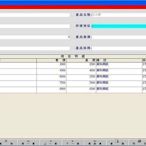進銷存系統推薦 相關
廣告多倉庫,多部門,多員工,不同區域分工合作,進銷存,庫存,生產,財務一站式管理。
過去一個月已有 超過 10 萬 位使用者造訪過 odoo.com
告別低效率重複性工作。雲端作業系統,切合公司遙距工作模式,提升營運效率,營收翻倍成長。 使用Odoo獨有的智能雙向輸入庫存功能實時追蹤所有庫存移動。
AI智能ERP ,智能托運,智慧型自動補貨,智能出貨一條龍,自動匯整訂單、同步庫存. 批發零售、網購業、連鎖門市必備進銷存系統,訂單出貨托運一條龍,數千家客戶見證!
過去一個月已有 超過 1 萬 位使用者造訪過 chi.com.tw
藥品必要資訊包含:產品編號、批號、健保碼,管制藥品許可證號,健保價格與藥價甲調查表. 藥業資料E化降低人工作業,資訊整合提高反應時效,作業流程標準化,解決藥業特殊 行業別特性管理
搜尋結果
![[羊咩咩3C]] 奕飛Qboss 維修進銷存系統 3.0 R2 精裝版 [羊咩咩3C]] 奕飛Qboss 維修進銷存系統 3.0 R2 精裝版](data:image/gif;base64,R0lGODlhAQABAIAAAAAAAP///yH5BAEAAAAALAAAAAABAAEAAAIBRAA7) $882[羊咩咩3C]] 奕飛Qboss 維修進銷存系統 3.0 R2 精裝版羊咩咩小鋪
$882[羊咩咩3C]] 奕飛Qboss 維修進銷存系統 3.0 R2 精裝版羊咩咩小鋪- $891$990進銷存系統購物中心
 $4980【全新附發票】弈飛 QBoss 進銷存系統 3.0 R2 單機版3C Mall 平價大賣場
$4980【全新附發票】弈飛 QBoss 進銷存系統 3.0 R2 單機版3C Mall 平價大賣場 $4250QBoss 維修進銷存系統 3.0 R2 - 單機版,支援Windows 8●Ready GO GO購● 3c專賣店
$4250QBoss 維修進銷存系統 3.0 R2 - 單機版,支援Windows 8●Ready GO GO購● 3c專賣店- $980QBoss 維修進銷存系統 3.0 R2 - 精裝版購物中心
![得億床墊彈簧床買賣進銷存系統 (單機版 + 區域網路版) 得億床墊彈簧床買賣進銷存系統 (單機版 + 區域網路版)]() $2500得億床墊彈簧床買賣進銷存系統 (單機版 + 區域網路版)得億電腦有限公司
$2500得億床墊彈簧床買賣進銷存系統 (單機版 + 區域網路版)得億電腦有限公司![SHINTI新緹 進銷存系統 商業整合專家單機版(進貨 銷售 庫存管理) SHINTI新緹 進銷存系統 商業整合專家單機版(進貨 銷售 庫存管理)]() $3000SHINTI新緹 進銷存系統 商業整合專家單機版(進貨 銷售 庫存管理)購物中心
$3000SHINTI新緹 進銷存系統 商業整合專家單機版(進貨 銷售 庫存管理)購物中心![【全新附發票】弈飛 QBoss 會計總帳 + 進銷存系統 3.0 R2 組合包 單機版 【全新附發票】弈飛 QBoss 會計總帳 + 進銷存系統 3.0 R2 組合包 單機版]() $8800【全新附發票】弈飛 QBoss 會計總帳 + 進銷存系統 3.0 R2 組合包 單機版3C Mall 平價大賣場
$8800【全新附發票】弈飛 QBoss 會計總帳 + 進銷存系統 3.0 R2 組合包 單機版3C Mall 平價大賣場![[羊咩咩3C]奕飛Qboss 維修進銷存系統 3.0 R2 單機版~(送鼠墊) (點擊有便宜) [羊咩咩3C]奕飛Qboss 維修進銷存系統 3.0 R2 單機版~(送鼠墊) (點擊有便宜)]() $6120[羊咩咩3C]奕飛Qboss 維修進銷存系統 3.0 R2 單機版~(送鼠墊) (點擊有便宜)羊咩咩小鋪
$6120[羊咩咩3C]奕飛Qboss 維修進銷存系統 3.0 R2 單機版~(送鼠墊) (點擊有便宜)羊咩咩小鋪![[羊咩咩3C]奕飛 Qboss 維修進銷存系統 3.0 R2 區域網路版 [羊咩咩3C]奕飛 Qboss 維修進銷存系統 3.0 R2 區域網路版]() $16920[羊咩咩3C]奕飛 Qboss 維修進銷存系統 3.0 R2 區域網路版羊咩咩小鋪
$16920[羊咩咩3C]奕飛 Qboss 維修進銷存系統 3.0 R2 區域網路版羊咩咩小鋪![QBoss 維修進銷存系統 3.0 R2 - 區域網路版 QBoss 維修進銷存系統 3.0 R2 - 區域網路版]() $11300QBoss 維修進銷存系統 3.0 R2 - 區域網路版●Ready GO GO購● 3c專賣店
$11300QBoss 維修進銷存系統 3.0 R2 - 區域網路版●Ready GO GO購● 3c專賣店![5Cgo【權宇】最新版正航一號 進銷存系統 或 會計系統 商務軟體(沒賣兩款合一) win7 win8 win10 含稅 5Cgo【權宇】最新版正航一號 進銷存系統 或 會計系統 商務軟體(沒賣兩款合一) win7 win8 win10 含稅]() $43905Cgo【權宇】最新版正航一號 進銷存系統 或 會計系統 商務軟體(沒賣兩款合一) win7 win8 win10 含稅快速服務官方5Cgo五西購物網
$43905Cgo【權宇】最新版正航一號 進銷存系統 或 會計系統 商務軟體(沒賣兩款合一) win7 win8 win10 含稅快速服務官方5Cgo五西購物網
George Town is the capital of the Malaysian state of Penang, encompassing Penang Island and surrounding islets. With a population of 794,313 as of the 2020 census, it is the core city of Malaysia's second-largest metropolitan area, which has a population of 2.84 million. George Town serves as the commercial centre for northern Malaysia.
This article has multiple issues. Please help improve it or discuss these issues on the talk page. (Learn how and when to remove these template messages) This article relies excessively on references to primary sources. Please improve this article by adding secondary or tertiary sources. Find sources: "List of Linux distributions" – news ...
An M.2 (2242) solid-state-drive ( SSD) connected into USB 3.0 adapter and connected to computer. The USB mass storage device class (MSC or UMS) standardizes connections to storage devices. At first intended for magnetic and optical drives, it has been extended to support flash drives and SD card readers.
- Control Operations
- Components
- Alarm Handling
- PLC/RTU Programming
- Plc Commercial Integration
- Communication Infrastructure and Methods
- Architecture Development
- Security
- Uses
- See Also
The key attribute of a SCADA system is its ability to perform a supervisory operation over a variety of other proprietary devices. 1. Level 0 contains the field devices such as flow and temperature sensors, and final control elements, such as control valves. 2. Level 1 contains the industrialised input/output (I/O) modules, and their associated dis...
A SCADA system usually consists of the following main elements: Supervisory computers 1. This is the core of the SCADA system, gathering data on the process and sending control commands to the field connected devices. It refers to the computer and software responsible for communicating with the field connection controllers, which are RTUs and PLCs,...
An important part of most SCADA implementations is alarm handling. The system monitors whether certain alarm conditions are satisfied, to determine when an alarm event has occurred. Once an alarm event has been detected, one or more actions are taken (such as the activation of one or more alarm indicators, and perhaps the generation of email or tex...
"Smart" RTUs, or standard PLCs, are capable of autonomously executing simple logic processes without involving the supervisory computer. They employ standardized control programming languages such as under, IEC 61131-3 (a suite of five programming languages including function block, ladder, structured text, sequence function charts and instruction ...
Since about 1998, virtually all major PLC manufacturers have offered integrated HMI/SCADA systems, many of them using open and non-proprietary communications protocols. Numerous specialized third-party HMI/SCADA packages, offering built-in compatibility with most major PLCs, have also entered the market, allowing mechanical engineers, electrical en...
SCADA systems have traditionally used combinations of radio and direct wired connections, although SONET/SDH is also frequently used for large systems such as railways and power stations. The remote management or monitoring function of a SCADA system is often referred to as telemetry. Some users want SCADA data to travel over their pre-established ...
SCADA systems have evolved through four generations as follows: Early SCADA system computing was done by large minicomputers. Common network services did not exist at the time SCADA was developed. Thus SCADA systems were independent systems with no connectivity to other systems. The communication protocols used were strictly proprietary at that tim...
SCADA systems that tie together decentralized facilities such as power, oil, gas pipelines, water distribution and wastewater collection systems were designed to be open, robust, and easily operated and repaired, but not necessarily secure. The move from proprietary technologies to more standardized and open solutions together with the increased nu...
Both large and small systems can be built using the SCADA concept. These systems can range from just tens to thousands of control loops, depending on the application. Example processes include industrial, infrastructure, and facility-based processes, as described below: 1. Industrial processes include manufacturing, process control, power generatio...
Linux (/ ˈ l ɪ n ʊ k s / LIN-uuks) is a family of open-source Unix-like operating systems based on the Linux kernel, an operating system kernel first released on September 17, 1991, by Linus Torvalds. Linux is typically packaged as a Linux distribution (distro), which includes the kernel and supporting system software and libraries, many of which are provided by the GNU Project.
The Global Positioning System (GPS), originally Navstar GPS, is a satellite-based radio navigation system owned by the United States government and operated by the United States Space Force. It is one of the global navigation satellite systems (GNSS) that provide geolocation and time information to a GPS receiver anywhere on or near the Earth where there is an unobstructed line of sight to ...
A "personal computer" version of Windows is considered to be a version that end-users or OEMs can install on personal computers, including desktop computers, laptops, and workstations. The first five versions of Windows– Windows 1.0, Windows 2.0, Windows 2.1, Windows 3.0, and Windows 3.1 –were all based on MS-DOS, and were aimed at both ...
![[羊咩咩3C]] 奕飛Qboss 維修進銷存系統 3.0 R2 精裝版 [羊咩咩3C]] 奕飛Qboss 維修進銷存系統 3.0 R2 精裝版](https://s.yimg.com/fz/api/res/1.2/tUzV8cUI4FjiNAtSbvscJw--~C/YXBwaWQ9c3JjaGRkO2ZpPWZpbGw7aD0xNDY7cT04MDt3PTE0Ng--/https://ct.yimg.com/xd/api/res/1.2/hQafzqLJdFEOqVfAiNIuPw--/YXBwaWQ9eXR3YXVjdGlvbnNlcnZpY2U7aD0zNDQ7cT04NTtyb3RhdGU9YXV0bzt3PTM0NA--/https://s.yimg.com/ob/image/3aa66e44-87bf-4612-8130-0dd41b48fe1c.jpg)







![[羊咩咩3C]奕飛Qboss 維修進銷存系統 3.0 R2 單機版~(送鼠墊) (點擊有便宜) [羊咩咩3C]奕飛Qboss 維修進銷存系統 3.0 R2 單機版~(送鼠墊) (點擊有便宜)](https://s.yimg.com/fz/api/res/1.2/Z19xkVYm0lRtvjVDDnFDxw--~C/YXBwaWQ9c3JjaGRkO2ZpPWZpbGw7aD0xNDY7cT04MDt3PTE0Ng--/https://ct.yimg.com/xd/api/res/1.2/o1hj_r2sjZRNdHNc9o68vw--/YXBwaWQ9eXR3YXVjdGlvbnNlcnZpY2U7aD0zNDQ7cT04NTtyb3RhdGU9YXV0bzt3PTM0NA--/https://s.yimg.com/ob/image/7116f507-aaa3-480a-87cd-958f9f700009.jpg)
![[羊咩咩3C]奕飛 Qboss 維修進銷存系統 3.0 R2 區域網路版 [羊咩咩3C]奕飛 Qboss 維修進銷存系統 3.0 R2 區域網路版](https://s.yimg.com/fz/api/res/1.2/.tdXN.bbSEnF6HeNjUngow--~C/YXBwaWQ9c3JjaGRkO2ZpPWZpbGw7aD0xNDY7cT04MDt3PTE0Ng--/https://ct.yimg.com/xd/api/res/1.2/rvFJFkmUC_LtsnfDOajOZw--/YXBwaWQ9eXR3YXVjdGlvbnNlcnZpY2U7aD0zNDQ7cT04NTtyb3RhdGU9YXV0bzt3PTM0NA--/https://s.yimg.com/ob/image/89e94b67-a6ef-4297-afd3-61e1cffeee1c.jpg)


